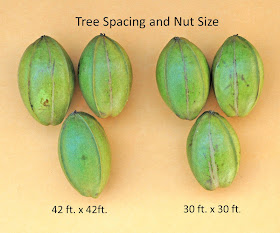Last winter I wrote about thinning a block of Kanza trees. If you recall, we thinned only a portion of a Kanza block last winter with additional tree removals planned for this coming winter. In any case, this left the planting with Kanza trees at two different tree spacings. The original planting was made at 30 ft. by 30 ft. (9.1 m x 9.1 m). After we thinned the trees on the diagonal, trees in the thinned portion of the orchard were spaced 42 ft. by 42 ft. (12.9 m x 12.9 m). Well, this summer's drought has got me thinking about tree spacing and its impact on tree water uptake. So this morning, I went out to collect some nut samples.
In theory, trees spaced wider apart should have more water available to them than trees spaced closer together. With more water available during a drought year (and no irrigation), wider spaced trees should have bigger and better filled pecans. To test this theory, I collected nuts from two trees of equal trunk diameter but one sample came from a tree in the thinned portion of the orchard while the other came from an unthinned area (photo above). If I stare at the photo long enough, it looks like the nuts from the thinned portion of the grove are slightly larger than the unthinned area.
Now, lets look at kernel fill (photo at right). Again, the differences between trees is slight with the unthinned kernel having a fraction more air space within the kernel.
My theory that wider spaced trees will produce larger and better filled nuts during a drought year may be true but the nut samples I collected today only gave us a hint in that direction. Could it be that the full effect of wider tree spacing hasn't kicked in yet? The orchard was only thinned last winter and the root systems of the remaining trees have yet to take full advantage of the greater soil resources now available to them.
Hopefully, we'll get some rain and all my worries about water and kernel filling will disappear.

